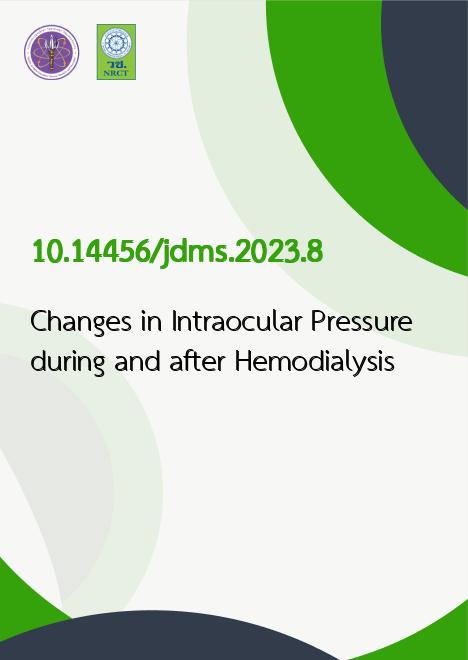
|
Changes in Intraocular Pressure during and after Hemodialysis |
|---|---|
| รหัสดีโอไอ | |
| Creator | Virunya Vachirasakchai |
| Title | Changes in Intraocular Pressure during and after Hemodialysis |
| Publisher | สำนักวารสารกรมการแพทย์ |
| Publication Year | 2566 |
| Journal Title | Journal of the Department of Medical Services |
| Journal Vol. | 48 |
| Journal No. | 1 |
| Page no. | 67-72 |
| Keyword | End-stage renal disease, Hemodialysis, Intraocular pressure |
| URL Website | https://he02.tci-thaijo.org/index.php/JDMS |
| Website title | วารสารกรมการแพทย์ |
| ISSN | 2697-6404 |
| Abstract | Background: The effects of hemodialysis (HD) on intraocular pressure (IOP) have been investigated foralmost 60 years since Sitprija et al. first reported IOP increases during HD in 1964. Subsequent studies have reporteddifferent results ranging from an acute increase in IOP to a decrease in IOP, as well as reporting no change at all.To our knowledge, high IOP is a significant factor in the development of glaucoma and glaucoma progression.Nevertheless, this issue is not really a significant concern for both ophthalmologists and nephrologists. Objective: Toevaluate changes in intraocular pressure during and after HD and to identify abnormal ocular symptoms. Method: Across-sectional observational study was conducted in Dialysis Unit 2 at Lerdsin Hospital from 4 February 2022 to 14April 2022. Demographic data, age, gender, underlying diseases, duration of HD (in months), ultrafiltration volume,and abnormal eye symptoms were recorded. The IOP was measured with an iCare PRO tonometer three times:before HD (Pre-HD), two hours after starting HD (2-hr HD), and after HD (Post-HD). Results: 41 end-stage renal diseasepatients (41 eyes) who received HD were enrolled. None of the participants experienced abnormal ocular symptomsat the time of HD. The mean IOP recorded were as follows: 22.49?4.67 mmHg at pre-HD, 23.65?4.61 mmHg at2-hr HD, and 24.92?4.42 mmHg immediately after HD. According to the multiple regression analysis, there was norelationship between ultrafiltration volume, pre-existing glaucoma, and IOP change after HD. Conclusions: IOP wasfound to be increased both during HD (2 hours) and immediately after HD. However, the statistical significance wasfound after HD only. |